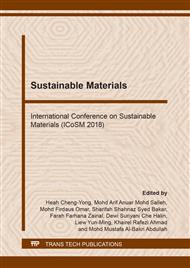[1]
Malkapuram, R., V. Kumar, and Y.S. Negi, Recent development in natural fiber reinforced polypropylene composites. Journal of Reinforced Plastics and Composites, 2009. 28(10): pp.1169-1189.
DOI: 10.1177/0731684407087759
Google Scholar
[2]
Akil, H., M. Zamri, and M. Osman, The use of kenaf fibers as reinforcements in composites. Biofiber Reinforce Composite Materials, (2015).
DOI: 10.1533/9781782421276.1.138
Google Scholar
[3]
Holbery, J. and D. Houston, Natural-fiber-reinforced polymer composites in automotive applications. Jom, 2006. 58(11): pp.80-86.
DOI: 10.1007/s11837-006-0234-2
Google Scholar
[4]
Fiore, V., G. Di Bella, and A. Valenza, The effect of alkaline treatment on mechanical properties of kenaf fibers and their epoxy composites. Composites Part B: Engineering, 2015. 68: pp.14-21.
DOI: 10.1016/j.compositesb.2014.08.025
Google Scholar
[5]
Rozman, H., L. Musa, and A. Abubakar, Rice husk–polyester composites: the effect of chemical modification of rice husk on the mechanical and dimensional stability properties. Journal of applied polymer science, 2005. 97(3): pp.1237-1247.
DOI: 10.1002/app.21268
Google Scholar
[6]
John, M.J. and R.D. Anandjiwala, Recent developments in chemical modification and characterization of natural fiber‐reinforced composites. Polymer composites, 2008. 29(2): pp.187-207.
DOI: 10.1002/pc.20461
Google Scholar
[7]
Anuar, H., et al., Tensile and impact properties of thermoplastic natural rubber reinforced short glass fiber and empty fruit bunch hybrid composites. Polymer-Plastics Technology and Engineering, 2006. 45(9): pp.1059-1063.
DOI: 10.1080/03602550600728794
Google Scholar
[8]
Hariharan, A.B.A. and H.A. Khalil, Lignocellulose-based hybrid bilayer laminate composite: Part I-Studies on tensile and impact behavior of oil palm fiber-glass fiber-reinforced epoxy resin. Journal of Composite Materials, 2005. 39(8): pp.663-684.
DOI: 10.1177/0021998305047267
Google Scholar
[9]
Mehta, G., et al., Effect of fiber surface treatment on the properties of biocomposites from nonwoven industrial hemp fiber mats and unsaturated polyester resin. Journal of applied polymer science, 2006. 99(3): pp.1055-1068.
DOI: 10.1002/app.22620
Google Scholar
[10]
Rozman, H., et al., The effect of glycidyl methacrylate treatment of empty fruit bunch (EFB) on the properties of ultra‐violet radiation cured EFB‐unsaturated polyester composite. Journal of applied polymer science, 2010. 115(5): pp.2677-2682.
DOI: 10.1002/app.29791
Google Scholar
[11]
Abdul Khalil, H.P.S., et al., The effect of various anhydride modifications on mechanical properties and water absorption of oil palm empty fruit bunches reinforced polyester composites. Polymer International, 2001. 50(4): pp.395-402.
DOI: 10.1002/pi.642
Google Scholar
[12]
Khalil, H.A. and N.L. Suraya, Anhydride modification of cultivated kenaf bast fibers: Morphological, spectroscopic and thermal studies. BioResources, 2011. 6(2): pp.1122-1135.
Google Scholar
[13]
Li, K., R. Qiu, and W. Liu, Improvement of interfacial adhesion in natural plant fiber-reinforced unsaturated polyester composites: A critical review. Reviews of Adhesion and Adhesives, 2015. 3(1): pp.98-120.
DOI: 10.7569/raa.2015.097301
Google Scholar
[14]
Hong, C., et al., Mechanical properties of maleic anhydride treated jute fibre/polypropylene composites. Plastics, Rubber and Composites, 2008. 37(7): pp.325-330.
DOI: 10.1179/174328908x314334
Google Scholar
[15]
Bessadok, A., et al., Alfa fibres for unsaturated polyester composites reinforcement: Effects of chemical treatments on mechanical and permeation properties. Composites Part A: Applied Science and Manufacturing, 2009. 40(2): pp.184-195.
DOI: 10.1016/j.compositesa.2008.10.018
Google Scholar
[16]
Edeerozey, A.M., et al., Chemical modification of kenaf fibers. Materials Letters, 2007. 61(10): p.2023-(2025).
DOI: 10.1016/j.matlet.2006.08.006
Google Scholar
[17]
Pickering, K.L., M.A. Efendy, and T.M. Le, A review of recent developments in natural fibre composites and their mechanical performance. Composites Part A: Applied Science and Manufacturing, 2016. 83: pp.98-112.
DOI: 10.1016/j.compositesa.2015.08.038
Google Scholar
[18]
Mishra, S., et al., Studies on mechanical performance of biofibre/glass reinforced polyester hybrid composites. Composites Science and Technology, 2003. 63(10): pp.1377-1385.
DOI: 10.1016/s0266-3538(03)00084-8
Google Scholar
[19]
Akil, H., et al., Kenaf fiber reinforced composites: a review. Materials & Design, 2011. 32(8): pp.4107-4121.
DOI: 10.1016/j.matdes.2011.04.008
Google Scholar
[20]
Cheng, Y., Y. Kuwun, and P. Phongsakon, Tensile properties and morphology study of polymeric composites. J Adv Manuf Tech, 2009. 3: pp.77-95.
Google Scholar
[21]
Mohanty, A.K., M. Misra, and L.T. Drzal, Natural fibers, biopolymers, and biocomposites. 2005: CRC Press.
DOI: 10.1201/9780203508206
Google Scholar
[22]
Panthapulakkal, S. and M. Sain, Injection‐molded short hemp fiber/glass fiber‐reinforced polypropylene hybrid composites—Mechanical, water absorption and thermal properties. Journal of Applied Polymer Science, 2007. 103(4): pp.2432-2441.
DOI: 10.1002/app.25486
Google Scholar
[23]
Atiqah, A., et al., Development of kenaf-glass reinforced unsaturated polyester hybrid composite for structural applications. Composites Part B: Engineering, 2014. 56: pp.68-73.
DOI: 10.1016/j.compositesb.2013.08.019
Google Scholar
[24]
Khalil, H.A., et al., Conventional agro-composites from chemically modified fibres. Industrial Crops and Products, 2007. 26(3): pp.315-323.
DOI: 10.1016/j.indcrop.2007.03.010
Google Scholar


